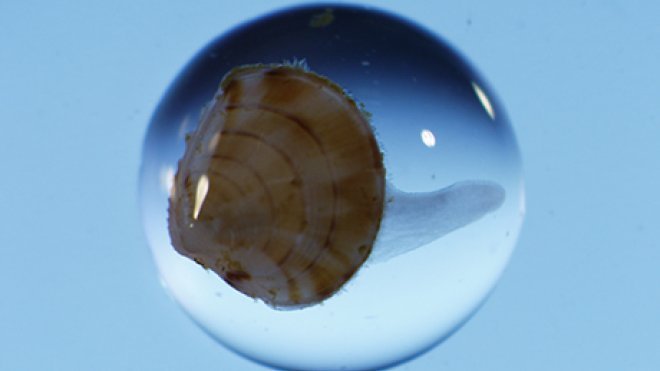Magnified Clam Image Captures Top Award in NOAA Photo Contest
Aquatic Diagnostic Technician Kathryn Markey Lundgren’s carefully constructed image of a tiny Northern quahog wins first place in National Oceanic and Atmospheric Administration’s aquaculture photo contest

BRISTOL, R.I. – Kathryn Markey Lundgren was scrolling through her Instagram feed last week when her thumb hovered over an image she knew well – her own photo, published to the National Oceanic and Atmospheric Administration Fisheries account. While seeing her photo spotlighted surprised her, the caption stunned Lundgren even more: “…take a minute to get your eyes on the winning photos in our Aquaculture Photo Contest, like this first-place stunner.”
Lundgren, an aquatic diagnostic technician in RWU’s Center for Economic and Environmental Development (CEED), found out first through Instagram, then later, a NOAA e-newsletter, that her photo been awarded first place in NOAA Fisheries’ inaugural aquaculture photo contest.
Using macrophotography technology, her image reveals a 2.5-millimeter-wide Northern quahog, Mercenaria mercenaria, magnified to 16 times its original grain-of-sand size and nestled within a perfect sphere of seawater. The sharpest eye will spy the clam’s translucent foot reaching out from the shell inside the water droplet.
“Originally, I took this photo to spot-check the health of the spats [young clams] which had been taken through their lifecycle and spawned right here in our hatchery by Shellfish Hatchery Manager Karin Tammi,” Lundgren recalls “But it just turned into a photo shoot, and I began trying to get better shots.”
Getting a picturesque shot of the spat wasn’t easy, according to Lundgren. Unlike two-dimensional specimens that are secured to a slide, her subject was three-dimensional – and alive and moving. She had to carefully drag individual clams away from the group cluster, and then get just the right amount of water in her pipet to dispense a single drop of water on top of the minuscule creature. Using an Olympus Stereo Microscope with a built-in camera, Lundgren operated the macrophotography frame and settings from her desktop to capture her shot.
Have no fear that its time as a model harmed the young quahog. Once the photo shoot wrapped, Lundgren placed the spat back in its tank, where it continued to thrive. “Clams live for quite a long time if you let them,” Lundgren says.
Throughout the course of her work, Lundgren photographs specimens to gauge health and growth. So she had a large collection of aquatic photos on hand when she was encouraged to enter NOAA’s photo contest by CEED Director / Professor of Biology Timothy Scott and Visiting Professor of Marine Biology Roxanna Smolowitz.
Through an up-close view of an animal many people are more familiar with as scrumptious morsels in clam chowder and stuffies, Lundgren strives to show another side to the underwater beings that inhabit the shoreline.
“Macrophotography allows people to see these smaller creatures from another perspective,” Lundgren says. “I hope that those who see this photo will appreciate that these clams also help our ecosystem.”